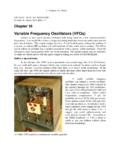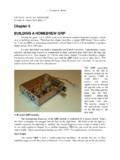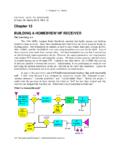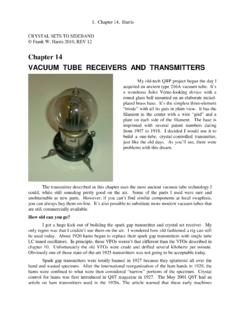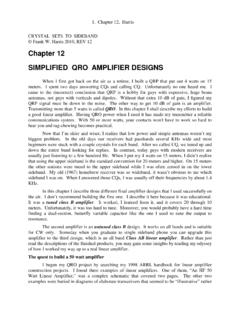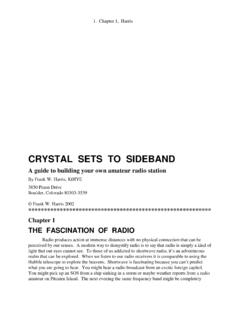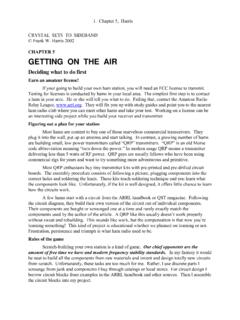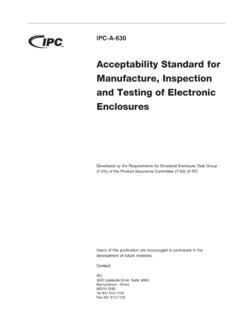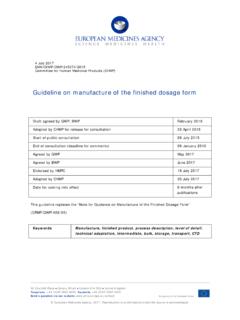Transcription of HOME-BUILDING AMATEUR RADIO EQUIPMENT
1 1. Chapter 2, Harris CRYSTAL SETS TO SIDEBAND Frank W. Harris 2010, Revision 12 CHAPTER 2 HOME-BUILDING AMATEUR RADIO EQUIPMENT What qualifies as homebuilding? The ultimate homebrewer would be a guy that walks off into the wilderness stark naked. Then, using rocks and sticks, he builds a high tech communications system. Hey, don t laugh! Our ancestors did it. Of course, they had to stay out in the woods for thousands of years to finish the job. Our ancestors were smart, hard-working folks. From our lofty position today it s easy to look down on them as some sort of blue-collar, country bumpkins. Ironically, country bumpkins are often more than they appear. In my opinion, today s family farmers are masters of a wider range of technology than any other group of people in our society. Farmers today can t afford to hire others to repair their old EQUIPMENT , so they have mastered skills from electrician to biologist.
2 Most farmers today have talents and knowledge that make the rest of us look like specialized robots on an assembly line. Building your own RADIO EQUIPMENT is fun and gives you the satisfaction that comes from mastering knowledge. Homebuilding doesn t need a precise definition. If you re having fun and learning something, do it! You should feel free to invent your own definition. However, the more levels of the technology pyramid you master, the bigger your achievement. Besides, buying ham EQUIPMENT is like skipping school and buying a diploma. You may get the same privileges, but the result will be empty in many ways. My personal definition of homebuilding is that I build my own EQUIPMENT starting from simple components that (I hope) I understand. I try never to buy EQUIPMENT or subassemblies specifically designed for AMATEUR RADIO . I am proud to be the bane of most of the advertisers in ham RADIO magazines.
3 I still buy individual electrical components, of course. I just pretend that the electronics industry never got around to inventing RADIO communications. An irony of our hobby is that, when the few remaining homebrewers retire from their day jobs, they often build and sell ham RADIO EQUIPMENT . These industrious guys manufacture and sell every imaginable ham gizmo. I doubt any of them have noticed that, by making everything readily available, they have discouraged homebuilding. When is homebrewing NOT appropriate? Homebuilding should not be done as a way to save money or procure modern EQUIPMENT . Modern multiband, HF ham transceivers are amazingly cheap. You should be able to buy a quality, used, high frequency SSB transceiver for as little as $500 - $1000. The good news is that many people in our society are so prosperous that parents can afford to give kids toys costing hundreds or even thousands of dollars.
4 The bad news is that the economic incentive for young hams to build something has almost vanished. Also, if you do build your own, even the most skilled homebuilder will not have enough years to build a truly equivalent, modern AMATEUR RADIO station. The commercial units contain custom integrated circuits, custom cabinets, and are the end result of multiple prototypes and exhaustive testing . 2. Chapter 2, Harris Homebuilding with vacuum tubes 50 years ago hams built reasonably good transmitters and receivers in their basements. A well-built homebrew could cover all the high frequency (HF) bands ( to 30 MHz). Best of all, its signal didn't embarrass you on the air. Homebrew CW and AM phone were routine. On the other hand, homebrew single sideband phone (SSB voice transmission) has always been rare because SSB is complex, or at least finicky, to generate. Circumstances have changed. If you could examine the complete schematic of a modern ICOM, Kenwood, or Yaesu transceiver, you will need a microscope to read it.
5 Of course if it s an F size engineering drawing, you might be able can read it OK, but the schematic wouldn t fit on your living room floor. In contrast, the schematic for a 1970 all-band, CW/ AM phone ham transmitter, complete with parts list, fits comfortably on one page of a ham RADIO magazine. In short, modern stuff is complicated. If they were just made of little vacuum tubes, it would still take hundreds of times longer to build them. But there are more differences. Frequency stability Nearly all hams today are using transceivers designed around precise, digital frequency synthesizers. The frequency is digitally displayed on a little LCD screen to precision as close as Hz. The numbers on the readouts may not be that accurate, but the average guy believes his dial is accurate because he hasn t read the specifications. For example, stability might typically be specified to 1 part in a million. So on the 10 meter band, 28 Megahertz, the precision of the display might be " Hz," but the guaranteed accuracy might be +/- 28 Hz.
6 However, if the commercial EQUIPMENT is reading an error of 28 Hz, it is still probably much more stable than a typical homebuilt oscillator. Consequently, when a homebuilt transmitter goes on the air and drifts more than about 20 Hz, it isn t long before the criticism begins. Today if a homemade transmitter frequency drifts like typical rigs of 40 years ago, the complaints will probably drive that ham off the air. In my limited experience, typical vintage ham transmitters from 35 or 40 years ago are likely to transmit poor quality signals that will provoke lots of complaints. On the other hand, if you are using top-of-the-line, best-quality, 40 year old EQUIPMENT , then the signal quality is likely to be acceptable. Chapter 14 illustrates the effort needed to build old-fashioned EQUIPMENT suitable for use on the air today. Yes, it can be done. But with such high standards, it s a challenge to make those old parts perform like modern EQUIPMENT .
7 Lead Inductance Another barrier to homebuilding transmitters today is lead inductance. The problem is that simple wires act like coils at high frequency. They resist RADIO frequency currents in proportion to the frequency - the higher the frequency, the greater the "impedance" to current flow. When the currents are tiny, like those used in 1960-era ham vacuum tube transmitters, this problem isn t severe. In an old tube transmitter, the plate voltage ranged from 500 to 2000 volts or even more. In accord with Ohm's law, small currents multiplied times the inductance times frequency = small voltage loss. And as you can see, starting with 500 volts, there was a lot of voltage to lose. In contrast, most modern transistorized transmitters run on 12 volts. Since 12 volts eliminates much of the power supply complexity, this sounds safe and easy. For operation in a 3. Chapter 2, Harris vehicle, you don t even need a power supply, you just run it directly off the battery using the cigarette lighter outlet.
8 12 volts DC supplies are safer and sound like good news. Unfortunately, if your power supply is only 12 volts, the currents in your transmitter will be 50 times higher for the same amount of power. Therefore the voltage drop across lead inductances will be 50 times higher and, starting with 12 volts, you don't have much voltage to lose. Suddenly each component in your circuit acts as if it has an inductor in series with it. These unwanted inductors cause the transistor stages to self-oscillate, or simply to produce no power gain. The bottom line is that it s much harder to build transistorized transmitters. The solution to the inductance problem is printed circuit boards and very short leads between the components. This means that the craftsmanship needed to build a transistorized transmitter is higher than we needed with vacuum tubes. If you don't carefully limit your goals and work within your knowledge and time constraints, the decision to homebrew your station can lead down a long road of frustration.
9 ** BASIC ELECTRICAL KNOWLEDGE The first challenge in building RADIO EQUIPMENT is acquiring the technical know-how. There are many ways to learn basic electronics. The American RADIO Relay League (ARRL) AMATEUR RADIO Handbook is published every year and has (nearly) everything you need to know. This large volume covers all aspects of the hobby. Unfortunately, its size is overwhelming for many readers. Also, so few hams build their own EQUIPMENT today that serious homebuilding has been de-emphasized in the Handbook. In fact, if all you had were the handbook, you would probably conclude that building your own EQUIPMENT is impractical. A goal of what you are now reading is to help restore homebuilding to some of the importance it once held in AMATEUR RADIO . This chapter introduces the minimum knowledge you need to get started. If you have trouble grasping the perhaps overly simplified explanations in this book, read about the same topics in the ARRL manual and other texts.
10 Much of the following is written in a Dick and Jane fashion that ignores many of the fine points. For example, if I say, all circuits are complete loops, a purist might bring up unusual situations in which this doesn t appear to be true. However, it s important to have some simple, bedrock concepts to fall back on which will usually serve you well. Rules of thumb are essential to keep your reasoning organized. However, keep your mind open to exceptions, because you ll encounter lots of them. When you do find exceptions, don t throw out the basic rules of thumb. They usually work well and will keep you sane. I only use math when it is essential to do the job. A serious problem with engineering schools is that engineering professors are selected from the 2% of the students who naturally think in terms of math. So after graduation, the math geeks are the guys who hang around to educate the next generation.
